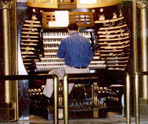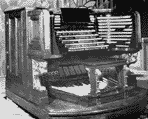 |
||
HighlightsThe Midmer-Losh Organ
The instrument has 449 ranks (365 flues, 84 reeds) and 337 stops, i.e. 314 voices (230 flues, 84 reeds) and 23 Percussions (7 melodic, 16 non-melodic). The pipes -- of which there are over 33,000 -- are placed in chambers behind ornamental grills in eight locations around the auditorium. There are ten 32-foot stops and the 64-foot pipe of the Pedal Right's Dulzian rank is said to have been made from a 785 year old Oregon Douglas Fir. The resonators of this stop's lowest notes contain more that 10,000 feet of lumber. The metal CCCC pipe of the Pedal Left's Diapason rank weighs around 2,200 pounds. The loudest stop is the Pedal Right's Grand Ophicleide (available at 16' & 8' pitches). Voiced on 100 inches of wind, it is described by the Guinness Book of World Records as having "a pure trumpet note of ear-splitting volume, more than six times the volume of the loudest locomotive whistle". Also on this pressure are the Solo organ's Tuba Imperial (8') and the Gallery I organ's Tuba Maxima (8'-4') and Trumpet Mirabilis (16'-8'-4'). There are ten voices on 50-inch wind pressure.
The instrument's weight is estimated to be 150 tons. Approximately 225,000 feet of lumber was used in its construction. The main pipe chests are supported by steel beams and frames. The seven-manual console has 1,235 stop-keys: 587 Flues, 265 Reeds, 35 Melodic Percussions, 46 Non-melodic percussions, 164 Couplers, 18 Tremolos and 120 Swell Pedal selectors.
Unusual names engraved on the stop-keys include: Vox Baryton, Bugle, Contra Spire Flute, Flute Sylvestre, Stentorphone, Musette Mirabilis, Pileata Magna, Trumpet Melody, Jubal Flute, Euphone, Egyptian Horn, Tibia Rex, Dulzard Twelfth, String Reed, Gamba Tuba Celeste, and Ocarina. The Echo organ's Bassoon (16'-8'-4') has resonators made of papier-mâché. The Convention Hall occupies four city blocks and cost between 15-20 million dollars. The main auditorium has a volume of approximately 15 million cubic feet and affords an unobstructed view from one end to the other for up to 41,000 people. |
||
|
|
||
Introduction • Main Auditorium Organ • Ballroom Organ Copyright 2000 • Atlantic City Convention Hall Organ Society, Inc. Site design & maintenance by metaglyph |
||
|
|
||


